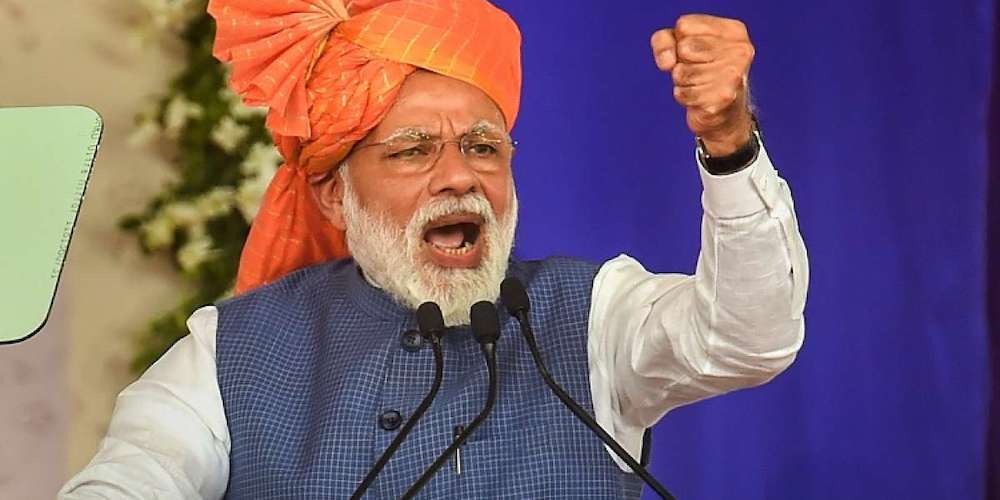RIGHT ANGLE – Modi Hai to Mumkin Hai

As one writes this evaluation of Prime Minister Narendra Modi and principal challenges confronting him on his 75th birthday, the neighbouring Nepal is undergoing political turmoil, with violent street protests led by the youth forcing the ouster of the government. Two other neighbouring countries – Bangladesh and Sri Lanka – also faced similar crises not long ago.
I hear Modi’s habitual critics fearing that India awaits the same fate. These fears need not be dismissed lightly, given the fact that India’s opposition parties, particularly the Congress led by Rahul Gandhi, and their left/liberal lunatic supporters have been systematically trying to unleash anarchy in the country in recent years. They have nearly crippled the functioning of the Parliament ( session after session gets washed away); they are challenging the credibility of constitutional bodies like the judiciary and the election commission. They say that the election commission must ensure their victory in the polls, that the courts must agree with whatever they say, and that the country must be run by the dictates of what the opposition says , not by what the elected government decides. These elements do not realise that the role of the opposition in a democracy is to suggest and oppose constructively, not obstruct the governance of the country.
This business of obstruction in India is supported no doubt by the hostile foreign forces. They had tried their best to defeat Modi and the NDA in the last general elections. They have been systematically trying to polarise the country on the caste and communal lines. So one will not be surprised if they repeat the same experiments in the streets of Delhi, Kolkata, Mumbai and Bengaluru. After all, they have had a huge success in Bangladesh in installing their puppets in power.
Of course, the situations in Nepal and Bangladesh are not comparable to those in India that led to these protests. But the challenges before Modi are formidable; he should be prepared for the attempted anarchy in the streets of India.
Admittedly, Modi is not K P Oli or for that matter Sheikh Hasina. He has formidable strength as India’s tallest leader and is acceptable to people in all corners of the country. People vote for Modi, more than his party the BJP or the NDA. Such are his charms.
And Modi’s achievements are unparalleled in India’s recent history. . As the prestigious Economist magazine, otherwise a critic of Modi, wrote recently, “ India has risen from being a desperately poor country reliant on food aid to becoming a net exporter of grain and a recognised nuclear power. It will soon be the world’s fourth-largest economy. Under the leadership of Narendra Modi since 2014, Indians have gained new confidence in their own identity, shedding some of the hang-ups inherited from past generations. The India of 2025 is, on the surface, a modern, self-assured nation”.
As I have written in the pages of this magazine many a time and as a traveller abroad, the Indian passport under Modi has become highly respectable. India’s policy of strategic autonomy and multi-alignment is a great success story under Modi, notwithstanding U.S. President Donad Trump’s highly personalised transactional policy against us. But that phase in the Indo-US relations will pass, sooner rather than later.
Some of the bold economic and political reforms that the country saw such as GST, Make in India or the abrogation of the Article 370 have been possible because of Modi. I doubt whether these would have been realisable if any other person was India’s Prime Minister. Similarly, it is Modi that dared successfully to take the fight against terrorism inside the interiors of Pakistan, be it the attack on Balakot in 2019 and the Operation Sindoor a few months ago.
I do not want to deal with all these achievements in detail as contributors to this special edition have enlightened the readers. Personally speaking, I have been a great admirer of Modi as well as a constructive critic, something any reader will find out by reading my columns in this publication and reading my book, “Prime Minister Modi: Challenges Ahead” that I wrote in 2017. The publisher has been after me to bring out a revised edition, but somehow I have been unable to do that.
Modi’s political opponents in Delhi’s so-called intellectual circles consider me a “Bhakt”, but for the “Sangh Parivar” I am always an outsider and hence as bad as an enemy. But then praises do not make me complacent. Criticisms do not disturb me. I admire Modi because he also does not believe in flatteries. And for me, he is a great leader as he is not afraid of taking hard decisions, something I discovered when as the Chief Minister of Gujarat he was not afraid of disconnecting electricity to those who did not pay.
Having said all this, let me now say that Modi of 2014 is not the same as Modi of 2025. Modi in 2014 was one of the rarest Indian politicians whose politics was not dependent on a particular caste or creed. But Modi’s language has changed now. He is also talking of caste as any other typical Indian politician. He seems to have copied his opponents’ “identity politics” because of political compulsions. At least that is the growing perception today.

Sadly, Modi has not been able to remove the perceptual problems associated with him. Many of his electoral reverses in general and the 2024 election in particular, have been due to the fact that his team has failed miserably in convincing people that his government is doing many good works.
Undoubtedly, Modi is the biggest communicator in the country at present, but he cannot communicate the government’s achievements alone. He does not have have enough competent ministers in his team or spokespersons who evoke credibility to propagate his government’s achievements – restoring the country’s overall financial health, excellent road-networks, empowering welfare schemes such as “Ujjwala Yojana”, “MUDRA Yojana,” the “Startup India” programmes, and the “Pradhan Mantri Fasal Bima Yojana”, direct cash transfer and opening up bank accounts for the poor, to name a few. In fact, compared to Modi’s rivals, they come out really miserably. As a result, there is now a widely-spreading negativity about Modi, which was not the case before.
Modi has not been able to do anything against “the Delhi establishment” that is intensely hostile to him. This establishment includes Delhi bureaucracy, Delhi intelligentsia and Delhi media. Many BJP or RSS members also belong to the Delhi establishment, which, deeply committed to Nehruvianism, is yet to reconcile with what it virtually thinks to be a hostile takeover by a rank outsider like Modi.
The second problem with Modi has been that he does not have enough sincere and committed people to monitor the progress of his well meaning schemes. Roads and common places are as dirty as in the past, despite initial success of his “Swachh Bharat” scheme. There are still spectacles of open defecation on railway tracks in the suburbs.
Modi has curtailed big-ticket corruption involving crores of rupees. In fact, in his 11 years in office in Delhi, his government has remained far away from a single scam, in sharp contrast with the multiple scams that marked the previous UPA regime led by the Congress party. Of course, the likes of Rahul Gandhi have done their best in talking of the non-existent corruption over the Rafale deal and the Pegasus spyware. The Supreme Court did expose the fragilities of these charges.
That Gandhi and his eco-system have not been impressed even after the Apex court verdicts is a different matter altogether. On the contrary, they, with their growing control over the foreign funded podcasters in the social media, are now creating a narrative that in Modi’s India, the corruption has gone down so much that without bribes to the officials at the lower and middle levels and commissions to BJP-appointed political functionaries, nothing happens for the common men.
It is high time Modi removed these perceptions, though the task is extremely challenging. After all, perceptions do matter most in politics.
All told, the Nehruian establishment that moulded many of our civil servants, politicians, media personalities and intellectuals is still formidable enough to resist Modi’s vision. His biggest pet project of “Make in India”, a project that could usher in real jobs, is not progressing speedily because many of his officials and colleagues, including from many from the BJP, have not been able to come out of the Nehruvian framework.
One cannot have millions of jobs without industries, whether big or small. But industries, in turn, require land, skilled manpower and infrastructure. But these are not available easily, given the political compulsions that Modi finds difficult to overcome. In fact, he has been forced to retreat from his attempts at liberalising the regressive land laws and really visionary farm-laws.
We have a situation in which nearly 70 per cent Indians are dependent on agriculture,a sector which contributes less than 14 per cent to the country’s GDP but continues to be pampered year after year. We are really not empowering them in the process, as they are being made to solely depend on government handouts. The only way out is for them to come out of farming, acquire skills and join industries, big or small.
One must commend that Modi wants to make India a developed country by the year 2047, 100th year of our independence. And for realising this he has the mantra of “ Reform, Perform and Transform”. The mantra is excellent. But then the challenge is in its implementation, something one has tried to explain in the paragraphs above.
In fact, when one talks of “performing”, having or promoting talents and skills again is the key. And here, Modi has to be strong enough to shun the age-old “identity politics”, particularly of caste and religion, the politics that talks of entitlement rather than empowerment. After all, we hear now the increasing demands of ever increasing reservations based on caste and creed.
Imagine a developed India where caste-based doctors are not able to give a good injection, professors not being able to write one paragraph clearly, engineers not able to do a job that an ordinary labourer can do, and the so called MBAs not comfortable in elementary mathematics and so on. A developed India cannot afford all this.
In fact, in India there are plenty of jobs, but there are no real talents to fill up those jobs. Employability, rather than employment, is the biggest crisis in India today. 80 percent of degrees are really a joke indeed!
As Nobel laureate economist Abhijit Banerjee, my university-contemporary, rightly suggests, the government jobs should be so “designed” to reduce their economically “perverse attraction” for millions of applicants and policies should be such that larger villages are turned into new towns and cropping patterns in the villages are changed.
These are formidable tasks. If at all, these can be done, then India needs a bold, strong, visionary and yet a popular leader. I do not see such a leader at the moment other than Modi. As they say, “Modi Hai To Mumkin Hai” (Modi can make everything possible)
[This piece was first published in Uday India]


